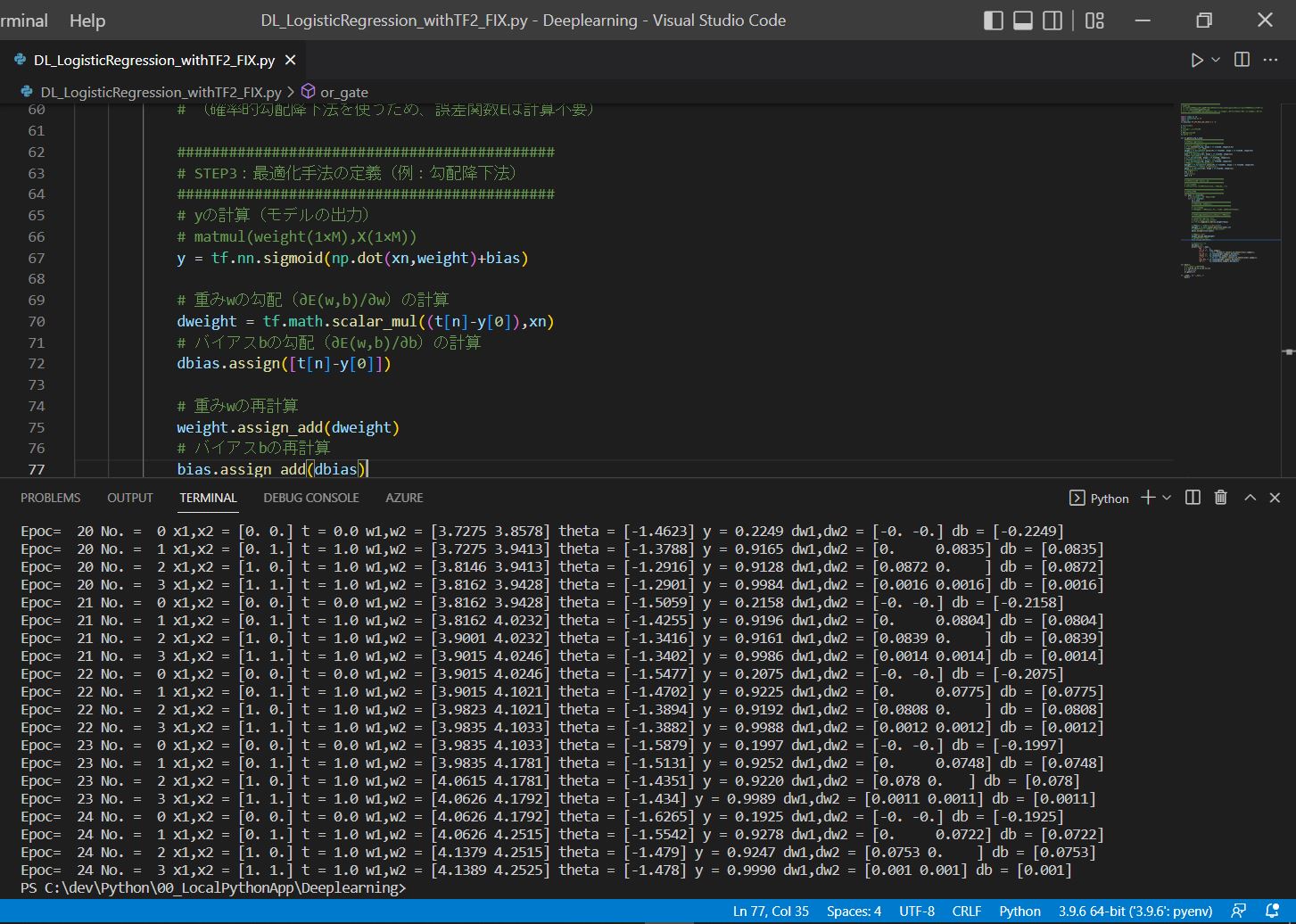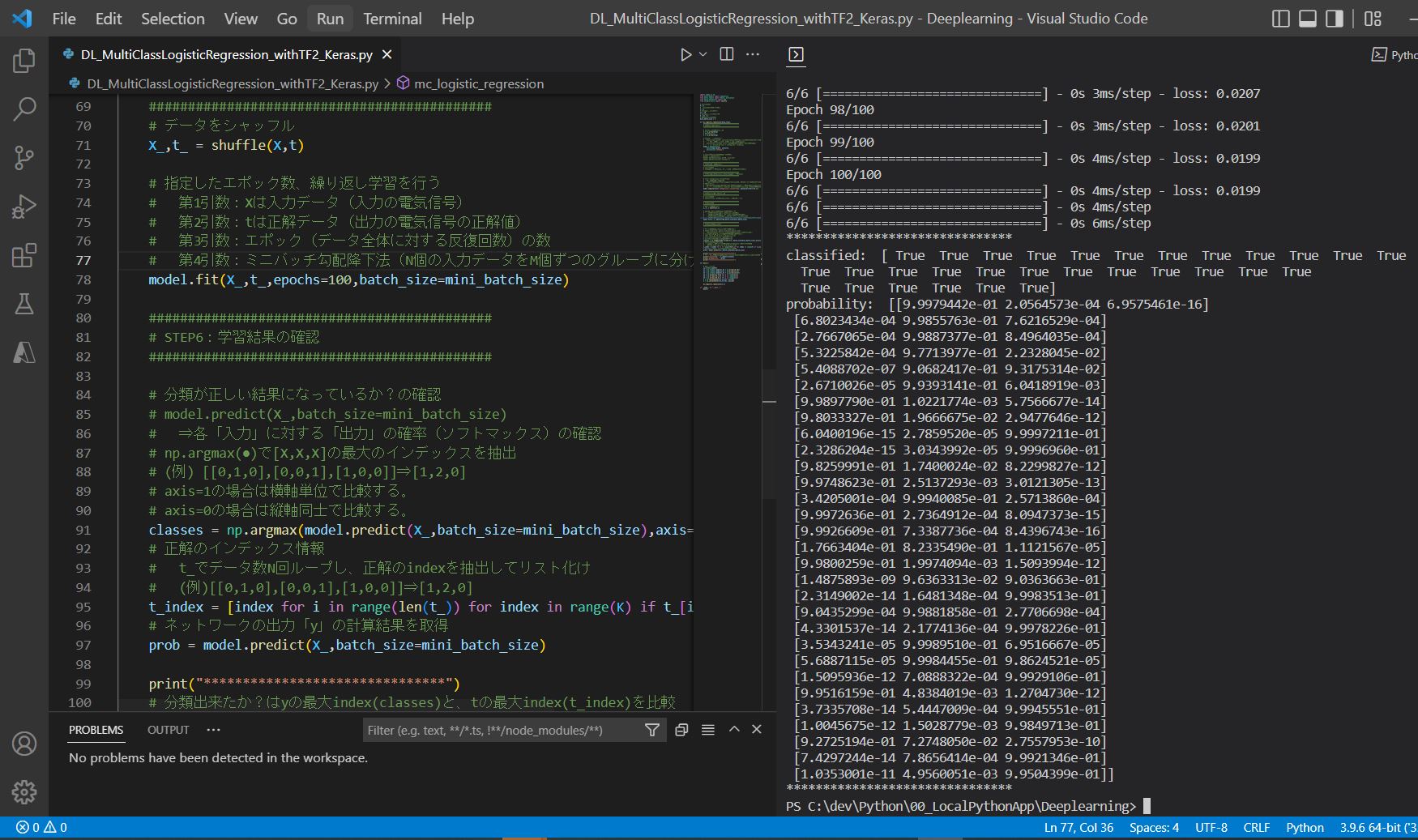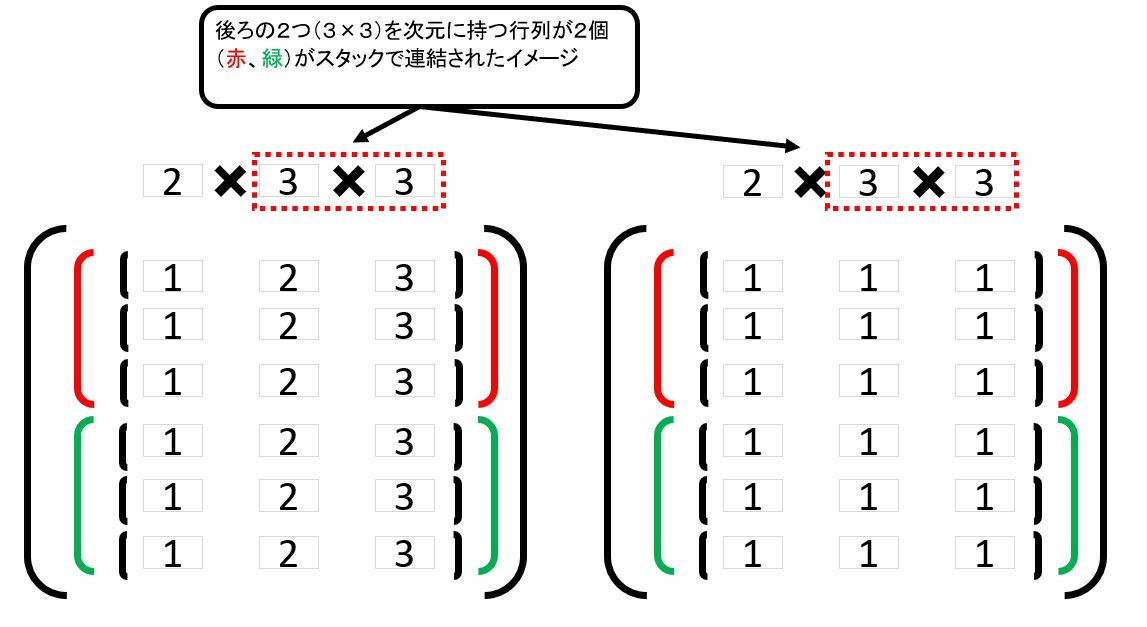<目次>
(1) ディープラーニングのロジスティック回帰をPythonで実装した例をご紹介
(1-1) 実装のフロー
(1-2) 実装例
(1) ディープラーニングのロジスティック回帰をPythonで実装した例をご紹介
(1-1) 実装のフロー
●STEP1:モデルの定義
●STEP2:誤差関数の定義
●STEP3:最適化手法の定義(例:勾配降下法)
●STEP4:セッションの初期化
●STEP5:学習
(1-2) 実装例

(サンプルプログラム)
import numpy as np
import tensorflow as tf
import os
os.environ['TF_CPP_MIN_LOG_LEVEL'] = '3'
# 入力xの次元
M = 2
# 入力データセットの数
N = 4
# ミニバッチの数
#n_batch = 4
def or_gate(X_arg,t_arg):
############################################
# STEP1:モデルの定義
############################################
# 入力の電気信号xの初期化
X = tf.constant(X_arg, dtype = tf.float64, shape=[N,M])
# 重みwの定義 ⇒[1行×M列]
weight = tf.Variable(tf.zeros([M],tf.float64), dtype = tf.float64, shape=[M])
# バイアスbの定義 ⇒[1行]
bias = tf.Variable([0], dtype = tf.float64, shape=[1])
# シグモイド関数:y = σ(wx + b)の定義 ⇒[1行]
y = tf.Variable([0], dtype = tf.float64, shape=[1])
# 正解値tの定義([[0,1,1,1]) ⇒[n行×1列]
t = tf.Variable(t_arg, dtype = tf.float64, shape=[N])
# 重みwの勾配(∂E(w,b)/∂w)の定義
dweight = tf.Variable(tf.zeros([M],tf.float64), dtype = tf.float64, shape=[M])
# バイアスbの勾配(∂E(w,b)/∂b)の定義
dbias = tf.Variable([0], dtype = tf.float64, shape=[1])
# 学習率ηの定義
eta = 0.1
# Epocの定義
epoc = 0
############################################
# STEP4:セッションの初期化
############################################
# ⇒今回は不要
# (TensorFlow v2以降はSessionを使用しないため)
############################################
# STEP5:学習
############################################
for epoc in range(25):
# バッチのデータ数だけ繰り返し
for n in range(N):
xn = X[n]
############################################
# STEP2:誤差関数の定義
############################################
# ⇒今回は不要
# (確率的勾配降下法を使うため、誤差関数Eは計算不要)
############################################
# STEP3:最適化手法の定義(例:勾配降下法)
############################################
# yの計算(モデルの出力)
# matmul(weight(1×M),X(1×M))
y = tf.nn.sigmoid(np.dot(xn,weight)+bias)
# 重みwの勾配(∂E(w,b)/∂w)の計算
dweight = tf.math.scalar_mul((t[n]-y[0]),xn)
# バイアスbの勾配(∂E(w,b)/∂b)の計算
dbias.assign([t[n]-y[0]])
# 重みwの再計算
weight.assign_add(dweight)
# バイアスbの再計算
bias.assign_add(dbias)
# コンソール出力
decimals = 4
print("Epoc= ",epoc,
"No. = ", n,
"x1,x2 =", X[n].numpy(),
"t =", '{:01}'.format(tf.convert_to_tensor(t[n]).numpy()),
"w1,w2 =", np.round(weight.numpy(),decimals),
"theta =", np.round(bias.numpy(),decimals),
"y =", '{:06.4f}'.format(tf.convert_to_tensor(y[0]).numpy()),
"dw1,dw2 =",np.round(dweight.numpy(),decimals),
"db =", np.round(dbias.numpy(),decimals))
def main():
# 初期値を設定し学習実行
X = [[0,0],[0,1],[1,0],[1,1]]
t = [0,1,1,1]
or_gate(X,t)
if __name__ == "__main__":
main()
(実行結果)
Epoc= 0 No. = 0 x1,x2 = [0. 0.] t = 0.0 w1,w2 = [0. 0.] theta = [-0.5] y = 0.5000 dw1,dw2 = [-0. -0.] db = [-0.5] Epoc= 0 No. = 1 x1,x2 = [0. 1.] t = 1.0 w1,w2 = [0. 0.6225] theta = [0.1225] y = 0.3775 dw1,dw2 = [0. 0.6225] db = [0.6225] Epoc= 0 No. = 2 x1,x2 = [1. 0.] t = 1.0 w1,w2 = [0.4694 0.6225] theta = [0.5919] y = 0.5306 dw1,dw2 = [0.4694 0. ] db = [0.4694] Epoc= 0 No. = 3 x1,x2 = [1. 1.] t = 1.0 w1,w2 = [0.626 0.7791] theta = [0.7485] y = 0.8434 dw1,dw2 = [0.1566 0.1566] db = [0.1566] ~中略~ Epoc= 24 No. = 0 x1,x2 = [0. 0.] t = 0.0 w1,w2 = [4.0626 4.1792] theta = [-1.6265] y = 0.1925 dw1,dw2 = [-0. -0.] db = [-0.1925] Epoc= 24 No. = 1 x1,x2 = [0. 1.] t = 1.0 w1,w2 = [4.0626 4.2515] theta = [-1.5542] y = 0.9278 dw1,dw2 = [0. 0.0722] db = [0.0722] Epoc= 24 No. = 2 x1,x2 = [1. 0.] t = 1.0 w1,w2 = [4.1379 4.2515] theta = [-1.479] y = 0.9247 dw1,dw2 = [0.0753 0. ] db = [0.0753] Epoc= 24 No. = 3 x1,x2 = [1. 1.] t = 1.0 w1,w2 = [4.1389 4.2525] theta = [-1.478] y = 0.9990 dw1,dw2 = [0.001 0.001] db = [0.001]
(図121)



